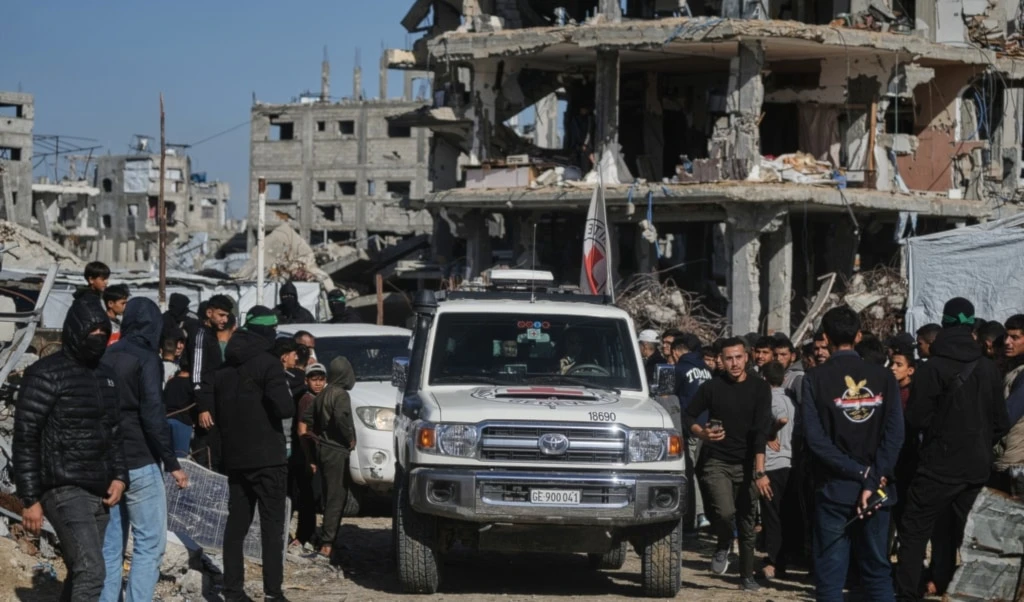AP: 'Israel' may have deliberately targeted journalists in hospital
An Associated Press investigation reveals that the Israeli military struck Nasser Hospital 4 times without warning, killing 22, including 5 journalists, with the probe questioning the military's rationale and use of tank shells in the attack.
-

People walk up stairs to the site of an Israeli strike at Nasser Hospital, minutes before a second round of strikes hit the same spot in Khan Younis, Gaza Strip, Monday, Aug. 25, 2025. This was one of the last photos taken by journalist Mariam Dagga, who freelanced for The Associated Press and other outlets, before she walked to the site and was killed in a second Israeli strike. (AP Photo/Mariam Dagga)
The Associated Press has conducted an extensive investigation into an Israeli military strike on Gaza's Nasser Hospital that killed 22 people, including five journalists, on August 25. Among the victims was Mariam Dagga, who worked for AP and other news organizations. The investigation raises serious concerns about the Israeli military's justification for the attack and how it was executed.
According to AP's reporting, Israeli forces targeted what they claimed was a Hamas observation post on the hospital's external stairwell. The military claimed they observed "suspicious behavior" involving a camera covered with a towel, which they interpreted as an attempt at concealment.
However, the Associated Press investigation revealed that the camera actually belonged to Reuters video journalist Hussam al-Masri, who was killed in the initial strike. AP gathered evidence showing that al-Masri routinely covered his equipment with white cloth, a standard practice among journalists worldwide to protect cameras from sun and dust. Witnesses told AP that al-Masri had been broadcasting live from this location almost daily for weeks prior to the attack.
The investigation found that Israeli forces had been observing the position by drone, including about 40 minutes before the strike, which should have provided sufficient time to properly identify al-Masri and recognize him as a journalist doing his job.
AP reveals four strikes without warning
AP's investigation documented that "Israel" struck the hospital four separate times on August 25, all without advance warning. The news agency's analysis also revealed several concerning aspects of how the attacks were carried out:
Within ten minutes of the first strike, Israeli forces hit the same location again while medical workers and journalists, including Dagga, had arrived to help the wounded and report on the incident. According to AP's reporting, experts in international law consider such "double-tap" attacks to potentially constitute war crimes, as they appear designed to target rescue workers and first responders.
Choice of weapons
The Associated Press found that Israeli forces used high-explosive tank shells rather than more precise guided munitions that could have reduced civilian casualties. A retired Israeli general quoted by AP stated there was "no good explanation" for using tank fire in this situation. Another Israeli official familiar with the attack told AP that tanks weren't supposed to have been used, though they couldn't specify what the original plan entailed.
The day after the strikes, Israeli forces provided a list of six men they claimed were "militants" killed in the attack. However, AP's investigation uncovered significant discrepancies in this account:
- No evidence was provided to support the "militant" designations
- One person named by "Israel" doesn't appear on the hospital's casualty list obtained by AP
- Another individual identified as a "militant" was actually a healthcare worker employed by the hospital
- A third was a driver for Gaza's Civil Defense emergency responders
Pattern of targeting Palestinian journalists
AP's investigation placed this incident within a broader context of journalist casualties. According to the Committee to Protect Journalists cited in the AP report, 189 Palestinian reporters have been killed by "Israel" in Gaza. While reports from the Government Media Office in Gaza put the number of Palestinian journalists killed by "Israel" at 248.
The Associated Press noted that "Israel" has prohibited foreign journalists from entering Gaza since the conflict began in October 2023, making Palestinian journalists crucial for war coverage.
The hospital served as a vital hub for Palestinian reporters due to its functioning medical facilities, reliable internet connection, and strategic location for covering the humanitarian crisis in Khan Younis.
Investigation methods and sources
The Associated Press based its investigation on extensive reporting, including interviews with nearly 20 witnesses who were at or near the hospital during the strikes. AP also consulted with current and former Israeli military officials, other occupation government sources, and weapons analysts to piece together what happened.
The news agency analyzed video footage from the time of the attacks, examined physical evidence including shrapnel, and reviewed satellite imagery showing Israeli military positions approximately 3 miles from the hospital.
Official responses
Israeli Prime Minister Benjamin Netanyahu called the incident a "tragic mishap", according to AP's reporting. The Israeli military also refused to comment when AP asked whether they had targeted the wrong person and has provided no evidence supporting their initial claims about Hamas activity.
The occupation army stated they are "conducting an investigation" but acknowledged "gaps" in how the attack was executed during their preliminary inquiry.
Both AP and Reuters issued a joint statement expressing outrage over the strikes and demanding accountability. The organizations questioned "whether Israel is deliberately targeting live feeds in order to suppress information."

 5 Min Read
5 Min Read








